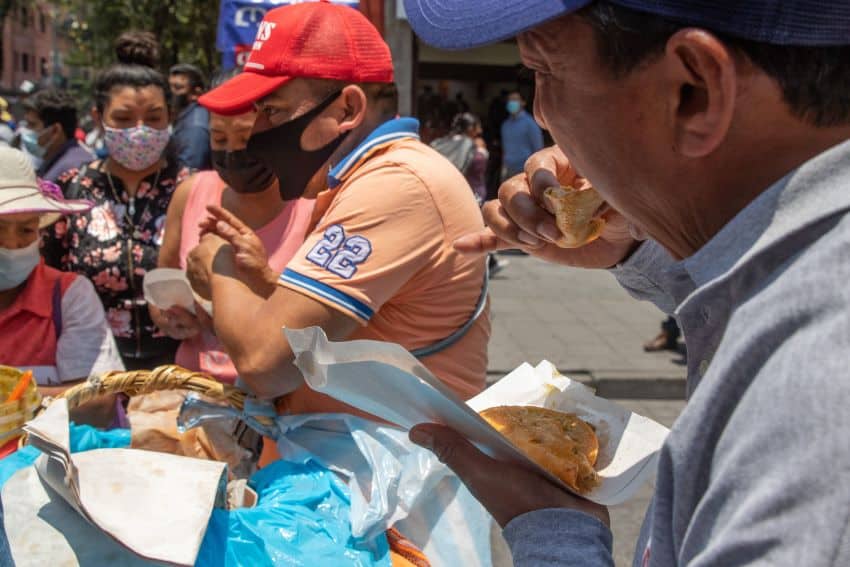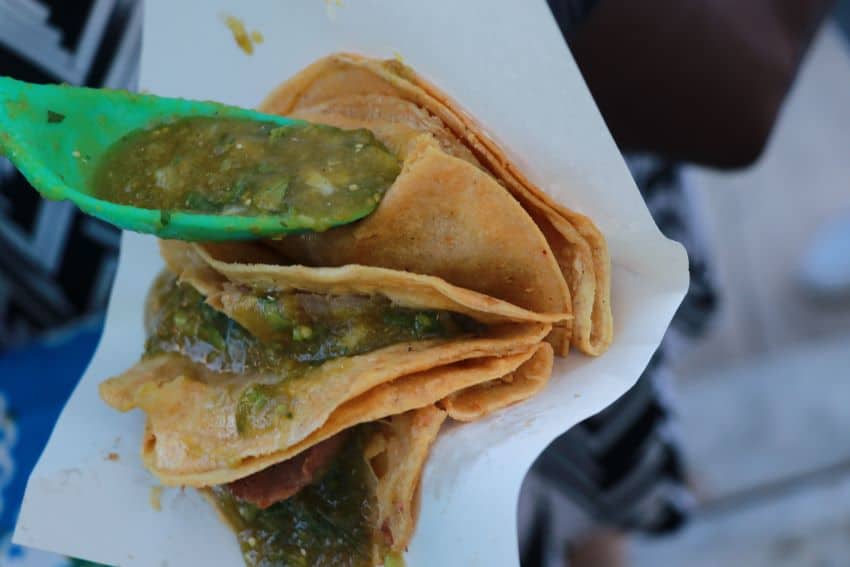You can usually identify them by the basket and the giant blue plastic bag that covers them: the taco de canasta — literally “basket taco” — is one of the kings of tacos in Mexico. You can also tell tacos de canasta by the fact that the sellers usually carry the basket on a bicycle and ride around the cities where they’re sold, and even some rural areas, hawking their wares.
This type of taco is easily recognizable by its small size and it is one of the most popular tacos in the country, in no small part because it is super affordable for many people — but their low price does not mean poor quality. And that’s where their charm lies: tacos de canasta are simply delicious and consistent in taste, making them a guaranteed delight to eat.

Normally made with stewed potatoes, chicharrón or beans — known as guisos in Spanish — these tacos are a must when you’re hungry because they are really filling. One of their more important qualities is their accompanying sauces: you can usually ask for spicy green or red salsa, pickled chilis or guacamole.
Another peculiarity of tacos de canasta is the system used to keep them warm, as each medium basket holds between 100 and 150 tacos, and large baskets can hold up to 200 tacos.
If you’re wondering what exactly we mean when we say the “system” that keeps them warm, we are referring to the fact that a layer of tacos is laid down, then a layer of onion and sometimes dried chilies and both layers are bathed in hot lard or adobo, with additional layers added until the basket is complete. The process of making them begins the night before, with the chef cooking the potatoes, beans and other ingredients for the stew, before finishing the preparation the next morning.
A brief history of tacos de canasta
Apolonio Piedra Sánchez was born 60 years ago in San Vicente Xiloxochitla, Tlaxcala, the same place where the classic tacos de canasta themselves are originally from.

He grew up making and selling tacos de canasta as a way of life. His story, and that of his family, is completely linked to the story of this dish. The practice of selling tacos out of a basket has existed for a long time of course, but the special method we know today was born in the early 20th century.
“We are from San Vicente Xiloxochitla. My whole family is from there. The tradition of making and selling tacos de canasta started with my grandfather, then continued with my father, and now with me,” Apolonio says.
When we asked Apolonio what makes tacos de canasta so special, he explained that the secret lies in the seasoning, including the marinades for the beans, chicharrón, potatoes and adobo.
In the 20th century, many taqueros traveled to Mexico City from other states — especially from Tlaxcala — to sell tacos. Nowadays, Apolonio says, people prepare tacos de canasta in states across Mexico.
The basics of making tacos de canasta

Want to make your own tacos de canasta? Today we are going to give you the basic recipe so you can.
The first thing you’ll need to know is that there are two salsas in this process: one that is spread on the tortillas and one that accompanies your tacos — the latter is up to you. You will, of course, need a basket!
For the tacos
- 1 kilo tortillas)
- Guisos of your preference (potato, chicharrón, beans)
For the salsa you’ll spread on all the tortillas
- 4 guajillo chilis, seeded
- 4 cloves garlic
- 3/4 liters of cooking oil
1/2 onion
- Put the chilis, onion, and garlic in a frying pan to roast until they take on a charred color.
- Once roasted, in the same pan, add a little oil and fry for 5 minutes.
- After frying, put everything in the blender, add salt to taste and the remaining oil.
- Transfer the blended mixture to a pot and heat very slowly until boiling.
- While the salsa is boiling, start filling your tortillas with the guiso of your preference. Fold and place in the basket, layering with onion slices. Spoon in boiling oil until you have the desired tacos.
- Once you finish arranging and bathing your tacos, close the basket and let it rest for 60 minutes.
- Serve with salsa to taste.
Enjoy your meal!
Ana Paula de la Torre is a Mexican journalist and collaborator for various outlets including Milenio, Animal Político, Vice, Newsweek en Español, Televisa and Mexico News Daily.
